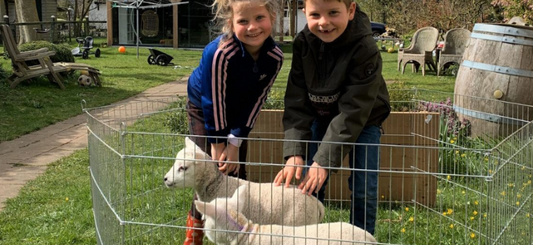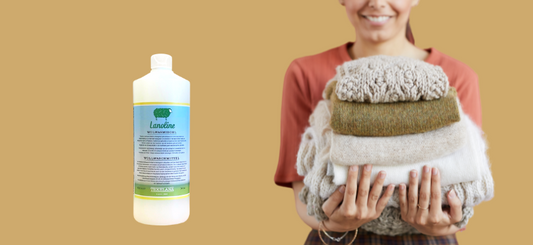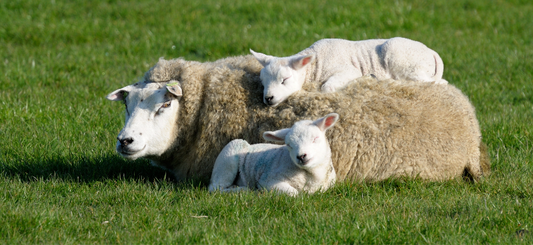We all experience it sometimes: poor sleep or difficulty falling asleep. While you're tossing and turning, you know how important a good night's sleep is. Rested, you're more productive, happier, and have better memory.
A key aspect of good sleep is maintaining the right body temperature: not too cold, but also not too warm. Wool is ideal for this. The material is airy, comfortably warm, and breathable. It retains heat when it's cold and ventilates when it's warm. Moreover, wool absorbs up to 30% of its own weight in moisture without feeling clammy.
Thanks to lanolin, the natural wool fat, wool is antibacterial, antifungal, and stain-resistant. It's important to open your duvet daily so that absorbed moisture can evaporate. This way, your bed stays fresh longer. With a wool duvet, you create a natural sleeping environment where you sleep comfortably and dry. Scientists haven't yet been able to recreate a fiber that matches these properties: wool is nature's high-tech fiber!
How do I know which duvet is best for me? This blog post will give you more information about the different duvets. Still having trouble? Contact our customer service team; we're happy to help!

Wool duvet pros and cons
Advantages:
- Temperature-regulating ; it keeps you warm when it's cold and ventilated when it's warm. Wool is an excellent insulator.
- Moisture regulating ; it easily absorbs moisture and lets it evaporate again into the air.
- Self-cleaning ; it is dirt and bacteria-resistant thanks to the natural protective layer (lanolin).
- Flame retardant ; due to its high moisture content and high ignition temperature, wool is a relatively safe material, making a wool duvet a good investment. The insulation value of wool hardly deteriorates. A wool duvet is strong and durable.
Disadvantages:
We can only think of advantages to a wool duvet. The only "disadvantage" we can mention is that a wool duvet can't be washed. Regularly airing a duvet is the best way to maintain it; airing the wool will prevent frizz and remove moisture. Dry cleaning is, of course, possible. We recommend doing this as little as possible to preserve the natural properties of wool.
The different Texelana duvet variants in one overview:
| Execution | Tick | Clutch | Filling |
| Standard 4 seasons | 100% cotton | zip |
Summer part 225 gr./m² Spring/autumn part 450 gr./m² |
| Excellent 4 seasons | Percale cotton | zip |
Summer part 225 gr./m² Spring/autumn part 450 gr./m² |
| Exquisite 4 seasons | Cotton satin | zip |
Summer part 225 gr./m² |
| Waddenparel 4-season | 100% cotton | snaps | Summer part 250 gr./m² Spring/autumn part 400 gr./m² |
| Excellent summer | Percale cotton | - | 225 gr./m² |
| Excellent spring/autumn | Percale cotton | - | 450 gr./m² |
| Excellent winter | Percale cotton | - | 600 gr./m² |
More explanation about the ticking, what are the differences?
Texelana offers three different types of ticking: cotton, percale cotton, and satin cotton.
- Cotton is a natural product and comes from the cotton plant. The fibers are spun into threads and used to make breathable textiles. Cotton has excellent properties: it breathes and absorbs moisture.
- Satin and percale don't refer to the material itself, but rather to the weaving method. Percale cotton is 100% natural cotton. It's woven with a higher thread count, making the fabric feel softer and more supple. The higher weave density also helps the fabric retain its beauty longer.
- Cotton sateen is 100% natural cotton; however, it feels softer and smoother than regular or percale cotton, thanks to its special "satin weave." This process involves weaving the cotton much more densely, using more threads. More threads per square inch means higher quality and a smoother fabric. The satin weave also gives the fabric a slight sheen.
Warmth classes
Duvets are classified into warmth classes, making it easy to find the right one. There are four warmth classes: 1, 2, 3, and 4.
- Class 1 is the thickest and warmest duvet. Texelana does not offer duvets in this warmth class.
- Class 2 is warm and is most commonly used in winter. This class includes our wool-filled 4-season duvets and the Excellent winter duvet .
- Class 3 is medium warm and best suited for the spring and autumn months. The Excellent spring/autumn duvet falls into this warmth class.
- Class 4 is the thinnest, least warm, and most suitable as a summer duvet. The Excellent summer duvet falls into this warmth class.
How is a wool duvet constructed?
Texelana's wool-filled duvets are constructed of several layers. The outer layer is the ticking, which is made of cotton, percale cotton, or sateen cotton. The middle layer is made of airy, carded sheep's wool. A thin fleece is placed between the wool filling and the ticking; this fleece is crucial because it keeps the wool filling in place, makes the duvet easier to sew through the sewing machine, and prevents the wool from seeping through the ticking.


Good to know:
- The ideal bedroom temperature is between 16 and 18 degrees Celsius.
- We recommend that you open the duvet when you get up instead of making the bed immediately.
- Ventilation is important, open your bedroom window for at least half an hour every day.
- Your duvet should be about 40 to 60 cm wider than your bed.
Which duvet suits me?
When choosing a duvet, it's important to consider your personal situation. Ask yourself questions like: How warm is my bedroom on average? Do I live in a well-insulated house, or can the temperature drop significantly at night? Am I a warm or cold sleeper? In both cases, wool is suitable because it regulates temperature. Warm sleepers should choose a lighter version, while cold sleepers should choose a warmer one. Also consider the season in which you plan to use the duvet and whether your living situation is likely to change in the near future.
Tip! Do you and your partner have different duvet preferences? Then you could opt for two single duvets.
A four-season duvet is the most complete duvet. It allows you to create the perfect amount of warmth. The duvet consists of a summer section and a spring/autumn section. These two duvets together create a wonderfully warm winter duvet.
Sleep comfortably all year round! Warmth classes 2, 3, and 4 in one duvet. View duvet .

A single duvet consists of one duvet. You can choose from a winter duvet, a spring/autumn duvet, and a summer duvet.
- The winter duvet is classified as warmth class 2, making it suitable for the cold winter months. And for the truly chilly among us.
- The spring/autumn duvet is classified as class 3, making it suitable if you have a well-insulated home and a fairly constant bedroom temperature.
- The summer duvet is classified as class 4, making it suitable for warm summer months and for those who tend to get warm quickly in bed.
All our Excellent variants have a percale cotton cover .
In a well-insulated house, a spring/autumn duvet is often sufficient for the winter months. However, we understand that you might still need a separate summer duvet or an extra warm winter duvet. In this case, we recommend a four-season duvet because it's more affordable than two separate duvets.
Texelana Excellent duvets. An excellent choice if you prefer a separate winter, spring/autumn, or summer duvet.
Texelana Excellent - single summer duvet
Texelana Excellent - single winter duvet
Texelana Excellent - single duvet spring/autumn
Texelana Underblanket made of sheep wool
The Texelana sheep's wool underblanket is the ideal addition to your sleeping arrangements. The pure new wool filling and the Wolborg top layer give this underblanket a luxuriously thick feel. It's filled with 100% pure, airy new wool from the Texel sheep breed (500 g/m²). The top layer is Wolborg, 100% pure new wool knitted into a tricot, also 500 g/m². This wool is naturally very pliable, creating a resilient layer with insulating properties. This keeps you comfortably warm and dry in cold weather and provides moisture management on warmer days. It features practical corner elastics. View wool underblanket.

Texelana Standard pillow, filled with sheep's wool
A Texelana pillow conforms perfectly to your head and neck, thanks to its soft, breathable wool ball filling. This pillow is moisture-regulating thanks to its sheep's wool filling.
Convenient; you can reorder bags of wool balls and refill the pillow as needed. For optimal effectiveness, we recommend airing and shaking the pillow regularly. The wool balls are easy to pull apart, which helps the wool retain its airy and springy structure.
Pillow filled with sheep's wool. The cover is made of 100% cotton and has a zipper. Filled with soft sheep's wool balls. View pillow .

Sheep wool products from the Texel sheep breed
Our sleep products are filled with wool from the Texel sheep breed. Incidentally, this breed isn't unique to Texel! This wool is ideal for use in duvets, underblankets, and pillows due to its cuddly texture and strong fiber. Its insulating and moisture-regulating properties create a dry sleeping environment, contributing to a healthy sleep environment and improved sleep quality.
Since Texelana doesn't have production capacity on Texel, all our wool duvets and wool underblankets are made elsewhere in the Netherlands. All our products are available in various sizes and thicknesses. With the different products, you can create the ideal combination to suit your sleeping needs. Sleeping on and under wool contributes to a wonderful night's sleep!
View all our wool-filled duvets and get inspired!







